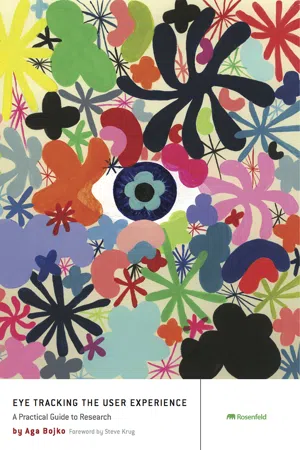
eBook - ePub
Eye Tracking the User Experience
A Practical Guide to Research
Aga Bojko
This is a test
- 320 pagine
- English
- ePUB (disponibile sull'app)
- Disponibile su iOS e Android
eBook - ePub
Eye Tracking the User Experience
A Practical Guide to Research
Aga Bojko
Dettagli del libro
Anteprima del libro
Indice dei contenuti
Citazioni
Informazioni sul libro
Eye tracking is a widely used research method, but there are many questions and misconceptions about how to effectively apply it. Eye Tracking the User Experience—the first how-to book about eye tracking for UX practitioners—offers step-by-step advice on how to plan, prepare, and conduct eye tracking studies; how to analyze and interpret eye movement data; and how to successfully communicate eye tracking findings.
Domande frequenti
Come faccio ad annullare l'abbonamento?
È semplicissimo: basta accedere alla sezione Account nelle Impostazioni e cliccare su "Annulla abbonamento". Dopo la cancellazione, l'abbonamento rimarrà attivo per il periodo rimanente già pagato. Per maggiori informazioni, clicca qui
È possibile scaricare libri? Se sì, come?
Al momento è possibile scaricare tramite l'app tutti i nostri libri ePub mobile-friendly. Anche la maggior parte dei nostri PDF è scaricabile e stiamo lavorando per rendere disponibile quanto prima il download di tutti gli altri file. Per maggiori informazioni, clicca qui
Che differenza c'è tra i piani?
Entrambi i piani ti danno accesso illimitato alla libreria e a tutte le funzionalità di Perlego. Le uniche differenze sono il prezzo e il periodo di abbonamento: con il piano annuale risparmierai circa il 30% rispetto a 12 rate con quello mensile.
Cos'è Perlego?
Perlego è un servizio di abbonamento a testi accademici, che ti permette di accedere a un'intera libreria online a un prezzo inferiore rispetto a quello che pagheresti per acquistare un singolo libro al mese. Con oltre 1 milione di testi suddivisi in più di 1.000 categorie, troverai sicuramente ciò che fa per te! Per maggiori informazioni, clicca qui.
Perlego supporta la sintesi vocale?
Cerca l'icona Sintesi vocale nel prossimo libro che leggerai per verificare se è possibile riprodurre l'audio. Questo strumento permette di leggere il testo a voce alta, evidenziandolo man mano che la lettura procede. Puoi aumentare o diminuire la velocità della sintesi vocale, oppure sospendere la riproduzione. Per maggiori informazioni, clicca qui.
Eye Tracking the User Experience è disponibile online in formato PDF/ePub?
Sì, puoi accedere a Eye Tracking the User Experience di Aga Bojko in formato PDF e/o ePub, così come ad altri libri molto apprezzati nelle sezioni relative a Computer Science e Computer Vision & Pattern Recognition. Scopri oltre 1 milione di libri disponibili nel nostro catalogo.
Informazioni
PART I
Why Eye Tracking?

CHAPTER 1

Eye Tracking: What’s All the Hoopla?
What Is Eye Tracking, Anyway?
Why Do the Eyes Move?
How Do the Eyes Move?
Why Should You Care Where People Look?
Why Do People Look at What They Look At?
Applications for Eye Tracking
Tool or Method?
Summary
Eye tracking, which is the process of identifying where someone is looking and how, has generated a great amount of interest in the user experience (UX) field since the beginning of the twenty-first century when the technology started becoming more widely accessible. Once a novel addition to the UX research toolbox, used by only a handful of early adopters, eye tracking is now frequently employed to help evaluate and improve designs (from websites to product packaging) at various stages of the development cycle.
Because it captures behaviors that are not easily controllable (by study participants) or observable (by researchers), eye tracking has been perceived as both more scientific and more “magical” than conventional usability testing methods. Initially, this perception resulted in eye tracking frequently being used for its own sake, regardless of study objectives. The common belief was that any study would produce better insight if accompanied by eye tracking.
When I started applying eye tracking to UX research in 2003, the typical approach in the field seemed to be “ready, fire, aim” or “track now, think later,” as we used to fondly call it. Practitioners would often turn on their newly acquired eye trackers and collect eye movement data with no consideration for the study design or the outcome. They would then embark on a fishing expedition, looking for data that might address their questions, failing to realize that they should have structured their study differently to obtain meaningful results.
While the mentality of eye tracking as the “be-all end-all” and the “tracknow-think-later” approach still exist to some extent, more and more practitioners realize that in order to learn something useful from eye tracking, more emphasis must be placed on science and less on magic. They recognize the importance of being aware of both the capabilities and limitations of eye tracking, knowing how to properly incorporate it into UX research, and learning how to interpret and communicate eye tracking findings. This book covers all these topics, but before we start diving into deep waters, let’s first examine the concept behind eye tracking.
What Is Eye Tracking, Anyway?
You are hopefully reading this book not because you want to build an eye tracker, but because you want to make use of eye tracking in your research. If that is the case, you do not need to know exactly how the hardware works to be successful in using it, just like you do not need to know what is under the hood of your car to be a good driver. However, as a professional, you should be at least somewhat well versed on the topic.
If you are already involved in eye tracking research, then you probably know what I mean. I am often asked about how eye tracking works by research stakeholders, other UX practitioners, study participants, and even my friends. And how can I blame them for their curiosity? Eye tracking is indeed fascinating.
Imagine that someone at a party overhears you mentioning eye tracking. Let’s call him John.
JOHN (wrinkling his forehead): Eye tracking? What is that?
YOU: Eye tracking is the process of determining where someone is looking. It can also measure the characteristics of eye movements and the eye itself, such as the size of the pupil. To conduct eye tracking, you need special equipment called an eye tracker.
JOHN: An eye tracker?
YOU: Yes, an eye tracker. It’s a piece of hardware that records your eye movements as you look at a computer screen, a physical object, or even your surroundings in general. Some eye trackers are affixed to a pair of glasses or a special hat you can wear. Others can be placed in front of you, like those that are attached to computer monitors.
JOHN: This sounds pretty cool. But how does it work?
YOU: The eye tracker shines infrared light onto your face, and then it records two things: the reflection of the infrared light from the retina, which helps find the center of your pupil, and the reflection of the infrared light from the cornea, which is called corneal reflection.
JOHN: Retina? Pupil? Cornea? You kind of lost me there.
YOU: The retina, pupil, and cornea are parts of the eye. Let me show you the eye diagram that I carry in my wallet for occasions such as this one (proudly taking the eye diagram from your wallet [see Figure 1.1]). The retina is a light-sensitive tissue in the back of the eye. The pupil is a black-looking opening that allows light to enter the retina. The cornea is the transparent front part of the eye.

FIGURE 1.1
The human eye.
The human eye.
JOHN (nodding): Uh-huh.
YOU: If you look at my eyes right now, you will see the corneal reflection of the light in this room in each of them. If I keep my head still and look to the left, to the right, up, and down (demonstrating), the corneal reflection doesn’t move—only the pupil does. You can see that the relationship between the pupil center and corneal reflection changes (see Figure 1.2).

FIGURE 1.2
The relative position of the pupil and corneal reflection changes when the eye rotates but the head remains still.
The relative position of the pupil and corneal reflection changes when the eye rotates but the head remains still.
JOHN: So where you are looking can be determined from the location of the pupil center relative to the corneal reflection.
YOU: Exactly. Now, if I move my head slightly while looking at the same spot (demonstrating), the relationship between the pupil center and corneal reflection remains the same (see Figure 1.3). Even though I’m moving, the eye tracker would know I’m looking at the same spot.

FIGURE 1.3
The relative position of the pupil and corneal reflection does not change when the head moves but the person is looking at the same spot.
The relative position of the pupil and corneal reflection does not change when the head moves but the person is looking at the same spot.
JOHN: So what’s inside of the eye tracker that allows it to do something like that?
YOU: Modern commercial eye trackers consist of two main components. The first one, a source of near-infrared light, creates the reflection in the eye. The second component is a video camera sensitive to near-infrared light. The camera is focused on the eye and records the reflection. The software then figures out the location of the gaze and superimposes it onto an image of what you were looking at, such as a Web page.
JOHN: Why is infrared light needed? Wouldn’t regular light work?
YOU: The trick is to use a wavelength that is invisible to people, and thus not distracting, yet reflected by the eye.
JOHN: But isn’t infrared light dangerous?
YOU: Any light wavelength—ultraviolet, visible, and infrared—can be harmful in high intensities, but the exposure from the eye tracker is just a tiny fraction of the maximum exposure allowed by safety guidelines. There is no danger, even if I were to track your eyes for hours.
This is when you and John realize that everyone else who was initially listening to your conversation has already walked away, and you decide to rejoin the party.
Why Do the Eyes Move?
If you take a step back just for a bit, you’ll realize that when people talk about eye trackers recording eye movements, they usually take it for granted that the eyes move. Out of the hundreds of conver...
